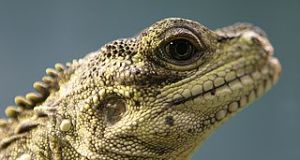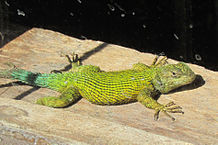Please see Green Anole Natural History for information concerning the natural history of the green anole and its relatives.
General
 Green anoles became a US pet trade staple in the 1960’s and early 70’s. Labeled “chameleons” due to their color-changing abilities, millions were collected in Florida and Louisiana and sold at circuses, fairs, pet stores and through the mail. In time, they became the “first lizard” for a generation of budding herpetologists. A host of grossly inappropriate supplies (including lapel chains!) and husbandry techniques assured most of the unfortunate creatures a short and unhappy captive existence.
Green anoles became a US pet trade staple in the 1960’s and early 70’s. Labeled “chameleons” due to their color-changing abilities, millions were collected in Florida and Louisiana and sold at circuses, fairs, pet stores and through the mail. In time, they became the “first lizard” for a generation of budding herpetologists. A host of grossly inappropriate supplies (including lapel chains!) and husbandry techniques assured most of the unfortunate creatures a short and unhappy captive existence.
My Less-Than-Promising Start
I remember well purchasing a green anole (packaged, oddly enough, in a small pie box) at the famous Ringling Brothers, Barnum and Bailey Circus at Madison Square Garden in the early 60’s. I knew enough to bypass the recommended diet of “sugar water and dried ant eggs” but was ignorant of the beast’s UVB requirements. I did, however, gather that it craved sunlight, and during one basking trip the lizard escaped up a caterpillar- laden apple tree where, I hope, it at least enjoyed the NYC spring and summer.
A Bit Delicate, but Well-Worth the Effort
Green anoles do reasonably well in captivity but are not the hardy, “starter lizards” they are often proclaimed to be. They are prone to stress-related ailments, require careful attention to the diet, and are quite sensitive to light, temperature and humidity levels.
That being said, I feel that their potential is largely ignored – a properly maintained group will readily display numerous social interactions, and makes as active and interesting a lizard exhibit as can be imagined. What’s more, establishing a colony of green anoles in such a situation is well within the financial and space constraints of many pet keepers, which cannot be said of most lizard species.
My co-workers at the Bronx Zoo frowned when I began adding green anoles to several large exhibits, but they (the lizards, not co-workers!) quickly became crowd pleasers. Even in an exhibit housing 2 huge water moccasins, it was the leaping, displaying anoles that drew most of the public’s attention.
Enclosure and Physical Environment
Green anoles are highly arboreal and will prefer the upper reaches of their enclosure. Branches of various thicknesses and orientations should be provided, along with plentiful sight barriers in the form of suspended live or artificial plants.
Despite their small size, green anoles require a good deal of room, as they are very active and are easily stressed by tight quarters or if confined too closely to one another. Ideally, a trio should be provided with a well-planted, 20 gallon aquarium.
Males are intolerant of each other. If several females are kept, horizontal and diagonally oriented basking sites (these are preferred over vertical branches) should be plentiful, as dominant animals will exclude others from these important areas.
Anoles do best in complex exhibits, especially those with live plants. They are quite easy on live plants, and really do look at their best when among them. Snake plants, pothos, Philodendron, peace lilies and many others will be well-used by these little gymnasts, and the areas between large leaves make naturalistic nocturnal retreats.
Arboreal shelters, in the form of cork bark and hanging plants, should be provided. These and similar sight barriers are important, as females will establish a dominance hierarchy, and subordinate animals may be inhibited from feeding or basking, even absent outright aggression.
The substrate should hold a bit of moisture but not be soggy. I recently used Exo-Terra Jungle Earth with a covering of Compressed Frog Moss and dead leaves in a public exhibit, and am pleased with the results. You can also use Keeper’s Choice Red Cypress, Exo-terra Forest Bark or Coconut Husk, with any type of moss mixed in.
Click here: The Green Anole (Anolis carolinensis carolinensis) in the Wild and Captivity – Care in Captivity Part 2, to read the rest of this article.
 That Reptile Blog – Reptile, Amphibian and Exotic Pet Care and Information
That Reptile Blog – Reptile, Amphibian and Exotic Pet Care and Information




I live in S. Florida. I caught a very small (about an inch long) green anole 4 or 5 days ago. I was planning on going out and purchasing one, but this little guy was just sitting inside the lobby of my building. At first I thought he might be dead, but he wasn’t. Just hiding from the colder night weather. I purchased a started terrarium and some live crickets. So far he seems to be doing well. I can’t tell if he’s eating the crickets. I put the first ones in there injured. Today I put two in there alive but they seem to be attacking him. So I wounded them. He now also seems to be ok with sitting on my hand for a while without trying to run away. Is there anything else I can do to help this little guy (or girl) along???
Thanks.
Hillary
Hello Hillary,
Frank Indiviglio here. Thanks for your interest in our blog.
Actually, an anole of that size is not very easy to keep. Larger crickets will definitely attack it, especially if temperatures cool down in the evening (the crickets are active at far lower temperatures than the anole). The anole will need very small crickets…pet stores specializing in reptiles sometimes carry different sizes…if you can locate one, ask for 10 day old or 1/4 inch crickets. Larger crickets, even if the lizard can down them, are likely to cause a blockage. Please see Part II of the article you referenced for some other feeding ideas.
Immature anoles need a good deal of calcium…food should be powdered with a vitamin/mineral supplement and a UVB-emitting bulb..
The terrarium’s temperature should be kept at 80-84F, with a basking spot of 90-95F (anoles experience cooler temperatures in winter, but keeping them warm in captivity is safest). If you haven’t misted the lizard with warm water, I suggest you do so ASAP…anoles will not drink from a water bowl, and small ones dehydrate rather easily.
Wild-caught anoles are usually high strung and should not be handled…the fact that yours tolerates handling may mean that it is in a weakened condition.
It might be preferable to release this animal and start off with an adult, or, preferably, a hardier species of lizard (perhaps a leopard gecko – captive bred, handleable, no need for UVB., long-lived)….Please let me know if you need further info or suggestions.
best regards, Frank Indiviglio.
I had just recently purchased a veil chameleon and i was told that it may be a male, it is 5 months old and im not sure if it male or not because it is said that males hace a little tarcel on their heal and i dont think mine has one. In the case that it is a female, will she have to lay eggs regaurdless of their being a mate. I read that if they dnt lay eggs they will become over engorged and end up dying. could you please give me some tips and info whether or not i will have any issues with having a female, and if she needs to lay eggs.
Hello, Frank Indiviglio here.
Nice to hear from you again,
What happens when unmated female veiled chameleons develop eggs varies greatly, and we don’t completely understand why some do fine and others do not. Some females resorb the developing eggs if they do not mate, and so fare well. Others simply lay the eggs, which do not hatch. Some do become egg-bound, which can lead to fatalities.
It is important to keep a gravid female well-hydrated and well nourished. Calcium is needed not only for egg shell formation, but for the strong muscle contractions needed to expel the eggs, so supplementation and UVB is critical. Also important is to provide a quiet stress free environment and a suitable laying site – a large flower pot with a foot or more of soil should be available.
If a female will not lay and appears in distress, a veterinarian can inject oxytosin to help move the eggs from her body.
Please see my article The Veiled Chameleon for a bit more general information.
Good luck, enjoy and please keep me posted.
Best regards, Frank Indiviglio.
Hello Frank,
We’ve have a s female Anole for some time now but we were not quite sure what was wrong with her.
Today we took her to the local scales & tails and she is egg bound with two eggs. This has been going on for approximately 3-4 weeks now and the gentleman at scales & tails told us that the eggs inside her were hard and were not moving. He gave her some calcium drops and advised us to feed her some peach baby food, which she ate but she is extremely thin and quite lethargic.
Is there anything that we can do to pass these eggs and survive? Can you recommend any locations in Colorado who might be able to help?
Thank you so much for taking the time to respond.
Laurie Saccomanno
Denver, Colorado
Hello Laurie, Frank Indiviglio here.
Thanks for your interest in our blog.
Unfortunately after this amount of time you’ll need veterinary intervention.
An Oxytosin injection is the usual treatment, although surgery is sometimes necessary if the animal is, as may be the case here, very debilitated. Calcium increases muscle contractions, which helps expel the eggs, but drops will not be effective at this point; vets often administer a Calcium Gluconate injection along with oxytosin.
Once the animal is treated, we can discuss steps you can take to avoid a recurrence.
Here is a list of Reptile-experienced veterinarians in Colorado; if none are convenient, call several and ask for a reference; it’s a limited specialty, so practitioners tend to be familiar with one another. Failing that, the reptile department of the closest zoo may be able to help, or write me and I’ll search further.
Good luck and please keep me posted… it’s very useful to have feedback on medical problems, thanks, Frank